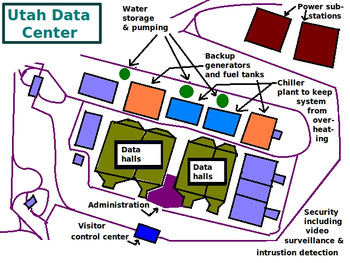Utah Data Center
From Wikipedia, the free encyclopedia
The Utah Data Center, also known as the Intelligence Community Comprehensive National Cybersecurity Initiative Data Center,[1] is a data storage facility for the United States Intelligence Community that is designed to be a primary storage resource capable of storing data on the scale of yottabytes (1 yottabyte = 1 trillion terabytes, or 1 quadrillion gigabytes).[2][3] Its purpose — as the name implies — is to support the Comprehensive National Cybersecurity Initiative (CNCI), though its precise mission is secret.[4] The National Security Agency, which will lead operations at the facility, is the executive agent for theDirector of National Intelligence.[5] It is located at Camp Williams, nearBluffdale, Utah, between Utah Lake and Great Salt Lake.
The data center is alleged to be able to capture "all forms of communication, including the complete contents of private emails, cell phone calls, and Internet searches, as well as all sorts of personal data trails—parking receipts, travel itineraries, bookstore purchases, and other digital 'pocket litter'."[2] According to the FISA Amendments Act of 2008, the federal government is legally prohibited from collecting, storing, analyzing, or disseminating the content of the communications of US persons, whether inside or outside of the United States, unless authorized by an individual warrant from the Foreign Intelligence Surveillance Court.[6]
The planned structure is 1 million or 1.5 million square feet[3][7][8] and it is projected to cost from $1.5 billion[9][10][11] to $2 billion when finished in September 2013.[2][3] One report suggested that it will cost another $2 billion for hardware, software, and maintenance.[3] The completed facility is expected to have a power demand of 65 megawatts, costing about $40 million per year.[2][3]
Contents[hide] |
Possible purposes[edit]
In August 2012 The New York Times published short documentaries by independent filmmakers entitled The Program,[12] planned for release in 2013, based on interviews with a whistleblower named William Binney, a designer of the NSA's Stellar Wind project. The program he worked on had been designed for foreign signals intelligence (SIGINT) collection but, after the September 11, 2001 terrorist attacks, Binney alleged that controls which limited unintentional collection of data pertaining to United States persons were removed, prompting concerns by him and others that the actions were illegal and unconstitutional. Binney alleged that the Bluffdale facility was designed to store a broad range of domestic communications for the purposes of data mining without warrants.[13]
However, Executive Order 12333, which governs United States intelligence activities, defines NSA's missions as protecting sensitive or classified US information from adversaries, or Information Assurance (IA), and collecting, processing, and disseminating intelligence information from foreign signals for intelligence and counterintelligence purposes and to support military operations, orSignals Intelligence (SIGINT).[14] NSA may monitor foreign communications, the collection of which do not require a warrant, including for those foreign communications which enter the United States and traverse US networks.[15][16][17] This mission does not include monitoring communications of Americans in the United States. An NSA spokesperson said, "Many unfounded allegations have been made about the planned activities of the Utah Data Center," and further said that "one of the biggest misconceptions about NSA is that we are unlawfully listening in on, or reading emails of, U.S. citizens. This is simply not the case."[5]
The temporary Protect America Act of 2007 (PAA) and the FISA Amendments Act of 2008 (FAA) clarified and codified the legal conditions with respect to foreign intelligence collection within the United States several years after Binney left NSA, allowing foreign SIGINT collection within the United States, but also specifying that an individualized warrant is required to collect on a US personanywhere in the world.[6] On December 29, 2012, FAA was reauthorized until December 31, 2017.
During the Obama Administration, the NSA has officially continued operating under the new FISA guidelines.[18] However, in April 2009 officials at the United States Department of Justice acknowledged that the NSA had engaged in "overcollection" of domestic communications in excess of the FISA court's authority, but claimed that the acts were unintentional and had since been rectified.[19]

